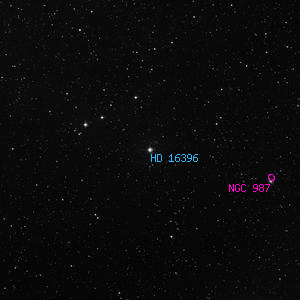HD 16396

Overlaid DSS image of HD 16396, 60' x 60' with north at top and west to the right
Aladin viewer for the region around HD 16396
Σ 285, BD+32 478, WDS J02388+3325AB, SAO 55748, GSC 02328-00372, HIP 12328
| Type | Star |
|---|---|
| Magnitude | 7.351 | Right Ascension | 2h 38' 45.9" (2000) |
| Declination | 33° 25' 9" N |
| Constellation | Triangulum |
| Classification | K2III+K2III |
Observing Notes
Captain William Henry Smyth
Feb 10, 1834 No. 6 The Crescent, Bedford, England (map)
150mm f/17.6 refractor by Tully 1827
A close double star, between the Fly and the Triangle; being the northern of a small trapezium of telescopic stars, lying in the direction of a line carried from γ Arietis through α —the first and third stars in the Ram's head —and extended about two-thirds farther. A 6½, yellow; B 10, grey. This exquisite and difficult object was dicovered by William Herschel in October, 1781, being his No. 21 of the First Class; but he only estimated a position and distance, which, however, approximate so nearly, that no motion can be assumed from the recent measures. Those of the Dorpat astronomer are:Pos. 340°40 Dist. 1".903 Ep. 1832.36The larger star is 13 Trianguli of Flamsteed, to which slight proper motions have been thus assigned:P.... RA -0".04 Dec. -0".02While this was in the press, I learned that Professor Struve had discovered, with the gigantic refractor at Poulkova, that the neighbouring star 89 P. II., was double; the components being of the 7½ and 8½ magnitudes, and 1½" apart.
B.... -0".03 +0".05
T.... -0".02 -0".01
[There is some confusion on identification here. Other references list H I 21 as HD 16396/WDS J02388+3325/Σ 285 quite some distance north and east of 13 Tri at 02h38m45s +33°25'08"
13 Tri is not a notable double star with no companion listed in WDS and no 10th magnitude star nearby visible in survey imagery or listed in the Gaia data. 13 Tri is as described the most northern star of a "trapezium" that includes 12 Tri and HD 15256.
The double star Smyth describes in the final paragraph is likely HD 15256/Σ 269 found 9' southwest of 13 Tri and 12' north of 12 Tri.
Musca Borealis, or the northern fly, was a constellation just southeast of Triangulum that was later incorporated into Aries. The body of this little fly was made up of the stars 33 Ari, 35 Ari, 39 Ari, and 41 Ari.]― A Cycle of Celestial Objects Vol II, The Bedford Catalogue, William Henry Smyth, 1844
Other Data Sources for HD 16396
Nearby objects for HD 16396
24 objects found within 120'
Credits...
Drawings, descriptions, and CCD photos are copyright Andrew Cooper unless otherwise noted, no usage without permission.
A complete list of credits and sources can be found on the about page
HD 16396